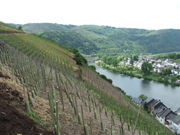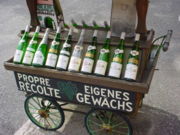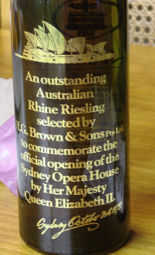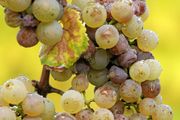Riesling
2007 Schools Wikipedia Selection. Related subjects: Drink
Riesling is a white grape variety and varietal appellation of wines grown historically in Germany (see German wine), Alsace (France), Austria, and northern Italy. It is a very old grape, first documented in 1435, in which year the storage inventory of the Counts of Katzenelnbogen (a small principality on the Rhine) lists the purchase of six barrels of riesslingen from a Rüsselsheim vintner. The modern word Riesling was first documented in 1552 when it was mentioned in Hieronymus Bock's Latin herbal.
The most expensive wines made from Riesling are late harvest dessert wines, produced by letting the grapes hang on the vines well past normal picking time. Through evaporation caused by the fungus Botrytis cinerea ("noble rot") or by freezing, as in the case of ice wine (in German, Eiswein), water is removed and the resulting wine offers richer layers on the palate. These concentrated wines have more sugar (in extreme cases hundreds of grams per liter), more acid (to give balance to all the sugar), more flavor, and more complexity. These elements combine to make wines which are amongst the most long lived of all white wines. The beneficial use of "noble rot" was discovered in the late 18th century at Schloss Johannisberg. Permission from the Abbey of Fulda, which owned the vineyard, to start picking the grapes arrived too late and the grapes had begun to rot, yet it turned out that the wine made from them was still of excellent quality.
Production regions
Riesling is considered one of the grape varieties that best expresses the terroir of the place where it is grown. It is particularly well suited for slate and sandy clay soil.
Germany
Originating in German soil today Riesling is Germany’s leading grape variety, known for its characteristic “transparency” in flavor and presentation of terroir, and its balance between fruit and mineral flavours. In Germany, Riesling normally ripens between late September and late November, and late harvest Riesling can be picked as late as January.
Three common characteristics of German Riesling are that they are rarely blended with other varietals, hardly ever exposed to commercial yeast and usually never exposed to oak flavor (despite some vintner fermenting in "neutral" oak barrels). To this last item there is an exception with some vinters in the wine regions of Palatinate (Pfalz) and Baden experimenting with new oak aging. The warmer temperatures in those regions produce heavier wines with a higher alcohol content that can better contend with the new oak. While clearer in individual flavours when it is young, a German Riesling will harmonize more as it ages, particularly around ten years of age.
In Germany, sugar levels at time of harvest is an important consideration in the wine's production with prädikat levels measuring the sweetness of the wine. As equally important to winegrowers is the balance of acidity between the green tasting malic acid and the more citrus tasting tartaric acid. In cool years, some growers will wait till November to harvest in hopes of having a higher level of ripeness and subsequent tartaric acid.
Before technology in wineries could stabilize temperatures, the low temperatures in winter of the northern German regions would halt fermentation and leave the resulting wines with natural sugars and a low alcohol content. According to local tradition, in the Mosel-Saar-Ruwer region the wine would then be bottled in tall, tapered, and green hock bottles. Similar bottles, although brown, are used for Riesling produced in the Rhine region.
In the late 19th century German horticulturalists devoted many efforts to develop new Riesling hybrids that would create a more flexible, less temperamental grape that could still retain some of the elegant characteristics of Riesling. The most notable is the Müller-Thurgau developed in Geisenheim in 1882, it is said to be a cross of Riesling and Silvaner though this has come under doubt. Other Riesling/Silvaner crosses include the Palatinate regional favorite Scheurebe and Rieslaner. Kerner, a cross between Riesling and the red wine grape Trollinger is a high quality cross that has recently eclipsed Riesling in plantings.
Riesling is also the preferred grape in production of Sekt, German sparkling wine.
Riesling wines from Germany cover a vast array of tastes from sweet to off-dry halbtrocken to dry trocken. Late harvest Rieslings can ripen to become very sweet dessert wines of the beerenauslese (BA) and trockenbeerenauslese (TBA) class.
Alsace
Riesling is on record as being planted in the Alsace region by 1477 when its quality was praised by the Duke of Lorraine. Today over a fifth of Alsace's vineyards are covered with Riesling vines, mostly in the Haut-Rhin district, with the wine produce here being very different from neighboring German Riesling. This is partly from difference in the soil with the clay Alsatian soil being more dominately calcareous then the slate composition of Rheingau. The other differences come in wine making styles, with the Alsatian preferring more French-oriented methods that produce wines of higher alcohol content (normally around 12%) and more roundness due to longer time spent aging in the barrel. In contrast to German wine laws, Alsatian rieslings can be chaptalized.
In contrast to other Alastian wines, Rieslings in this area are not meant to be drunk young. Rieslings produce here tend to be mostly very dry with a cleansing acidity. They are thick bodied wines that coat the palate. These wines age exceptionally well with a quality vintage aging up to 20 years. This is beneficial since the flavors in an Alsace wine will often open up after three years, developing softer and fruitier flavours. Rieslings made in sweeter styles include the late harvest Vendange Tardive and the botrytize Sélection de Grains Nobles.
In addition to Muscat, Gewürztraminer and Pinot Gris, Riesling is one of the acceptable varieties whose planting is allowed in Alsace's grand cru sites.
Australia and New Zealand
In 1838 William Macarthur planted Riesling vines near Penrith in New South Wales. Riesling was the most planted white grape in Australia until the early 1990s when Chardonnay greatly increased in popularity. Riesling still flourishes in the Clare Valley, in particular the areas of Watervale and around the Polish Hill River, and the cooler Eden Valley where some sparkling Riesling is produced. The warmer Australian climate produces thicker skinned grapes, sometimes seven times the thickness of German grown grape. The grapes ripening in free drain soil composed of red soil over limestone and shale, producing a lean wine that as it matures produces toasty, honeycomb and lime aromas and flavours. It is common for Australian Rieslings to be fermented at low temperatures in stainless steel tanks with no oxidation of the wine and followed by earlier bottling.
Australian Rieslings are noted for their oily texture and citrus fruit flavours in their youth and a smooth balance of freshness and acid as they age. The botrytized Rieslings have immense levels of flavor concentrations that have been favorably compared to lemon marmalade.
Riesling was first planted in New Zealand in the 1970s and has flourished in the relatively cool climate of the Marlborough area and for late harvests in the Nelson region. In comparison to Australian Riesling, New Zealand produces lighter and more delicate wines that range from sweet to dry.
Austria
Riesling is the second leading white grape varietal after the indigenous Grüner Veltliner. Austrian Riesling is generally thick bodied, coating the palate and producing a strong clarity of flavor coupled with a mouthwatering aroma. A particular Austrian Riesling trademark is a long finish that includes hints of white pepper. It flourishes in the cool climate and free-draining granite and mica soil of the Wachau region where Austrian wine laws allow for irrigation. With levels normally around 13% it is has a relatively high alcohol content for Riesling and is generally at its peak after 5 years. Austrian Riesling is not known for its sweetness and is mostly dry with very little grapes affected by botrytis.
North America
In the late nineteenth century German immigrants brought with them Riesling vines, named Johannisberg Riesling, to qualify them as “legitimate” German Riesling. New York, particularly in the Finger Lakes region, was one of the earliest U.S. producers of Riesling. Plantings started to appear in California by 1857 and followed in Washington State in 1871.
New York Riesling generally has a characteristic effervescent light body with a similarly light, mellow flavor. The wine can be dynamic though rarely robust, and ranges from dry to sweet. New York is also a notable producer of Riesling based Ice Wine, although a large majority of New York Ice Wine is made from Vidal Blanc and Vignoles.
In California, Riesling lags far behind in popularity to Chardonnay and is not as commonly planted. A notable exception is the growing development of high quality Late Harvest dessert wines. So far, the Late Harvest wines most successfully produced are in the Anderson and Alexander Valleys where the weather is more likely to encourage the needed botrytis to develop. The Riesling that does come out of California tends to be softer, fuller, and having more diverse flavours than a "typical" German Riesling.
In the Pacific Northwest there is a stark contrast in Riesling production, the grape is currently on the rise in Washington State but on the decline in neighboring Oregon. Riesling from this area ranges from dry to sweet, and has a crisp lightness that bodes well for easy drinking. Often there will be an easily detectable peach and mineral complex. Some Washington State winemakers, such as Chateau Ste. Michelle, are adapting German style Riesling production methods, and even partnering with well-known German vintners like Dr. Ernest Loosen to create specialty wines such as the Eroica Riesling. Pacific Rim is another Pacific Northwest winery that specializes almost entirely on Riesling in its various forms.
Niagara Peninsula, Ontario, Canada
In Canada, Riesling is commonly used for Ice Wine, particularly in Ontario, where the wine is noted for its breadth and complexity. Niagara is a major producer of ice wine in general, putting it neck-and-neck with Germany. Late Harvest wines and some sparkling wines are produced with Riesling in Niagara but it is table wines from dry to off-dry that hold the largest share of production. The climate of the region is typically quite warm in the summertime which adds a layer of richness in the wines. It is interesting that the founder of St. Urbanshoff in the Mosel, Herman Weiss, was an early pioneer in Niagara's modern viticulture, selling his strain of Mosel clone Riesling to many producers in west Niagara (these vines are well over 20 years old now). This clone and Niagara's summer heat make for uniquely bright wines and often show up in interesting dry styled versions. Many producers and wine critics will argue that Niagara's best offerings come from the Niagara Escarpment region which encompasses the Short Hills Bench, 20 Mile Bench and Beamsville Bench.
Other regions
Riesling is also widely grown in South Africa, Chile and Central Europe, particularly Romania.
Production
In wine making, the delicate nature of the Riesling grape requires special handling during harvesting to avoid crushing or bruising the skin. Without this care, the broken skins could leak tannin into the juice, giving a markedly coarse taste and throwing off balance the Riesling’s range of flavours and aromas.
A wine that is best at its “freshest” states, the grapes and juice may be chilled often throughout the vinification process. Once, right after picking to preserve the grapes' more delicate flavours. Second, after it has been processed through a bladder press and right before fermentation. During fermentation, the wine is cooled in temperature controlled stainless steel fermentation tanks kept between 10°-18°C (50°-65°F). This differs from red wines that normally ferment at 24°-29°C (75°-85°F)
Unlike Chardonnay, most Riesling do not undergo malolactic fermentation. This helps preserve the tart, acidic characteristic of the wine that gives Riesling its “thirst-quenching” quality. (Producers of Sauvignon Blanc and Pinot Grigio often avoid malolactic fermentation for the same reason.) Riesling is often put through a process of cold stabilization, where the wine is stored just above its freezing point. The wine is kept at this temperature until much of the tartaric acid has crystallized and precipitated out of the wine. This helps prevent crystallization of the acid (often called "wine diamonds") in the bottle. After this, the wine is normally filtered again to remove any remaining yeast or impurities.
In viticulture, the two main components in growing Riesling grapes are to keep it "Long & Low" meaning that the ideal situation for Riesling is a climate that allows for a long, slow ripening and proper pruning to keep the yield low and the flavor concentrated.
With food
Riesling is a very versatile wine to have with food, because of its balance of sugar and notable acidity. It can pair with white fish, or with pork, and it is one of the few wines that can stand up to Thai and Chinese cuisine. Riesling's typical aromas are of flowers, tropical fruits, and mineral stone (such as slate or quartz), although, with time, the wine acquires a petrol or kerosene note that may be immediately arresting to new drinkers of Riesling while others may find it alluring.
Riesling is almost never fermented or aged in new oak (although large, old oak barrels are often used to store and stabilise Riesling based wines in Germany and Alsace). This means that Riesling tends to be lighter weight and therefore suitable to a wider range of foods. The sharp acidity/sweetness in Rieslings can serve as a very good balance to foods that are high in salt content. In Germany, Cabbage is sometimes cooked with riesling to help taper the smell.
As with other white wines, dry Riesling is generally served at 11°C (52°F). Sweeter Rieslings are often served warmer.
Labelling of Riesling
Other names for Riesling are Johannisberg Riesling (named after the famed Schloss Johannisberg), White Riesling and Rhine Riesling. In Italy it is sometimes labeled Riesling Renano.
Many grapes that incorporate the name Riesling are not true Riesling. For example, Grey Riesling is actually Trousseau Gris, an unrelated grape. Schwarzriesling ("black Riesling") is also known as Pinot meunier, a grape also used in the production of Champagne. In South Africa, the French grape Crouchen is known as Cape Riesling in contrast to "real Riesling" which is labeled in South Africa as Weisser (or White) Riesling.
Longevity
Riesling's naturally high acidity and range of flavours make it suitable for extended aging. International wine expert Michael Broadbent rates aged German Rieslings, some hundreds of years old, extremely highly.
The townhall of Bremen, Germany, stores various German wines, including Riesling based wines, in barrel back to the 1653 vintage.




